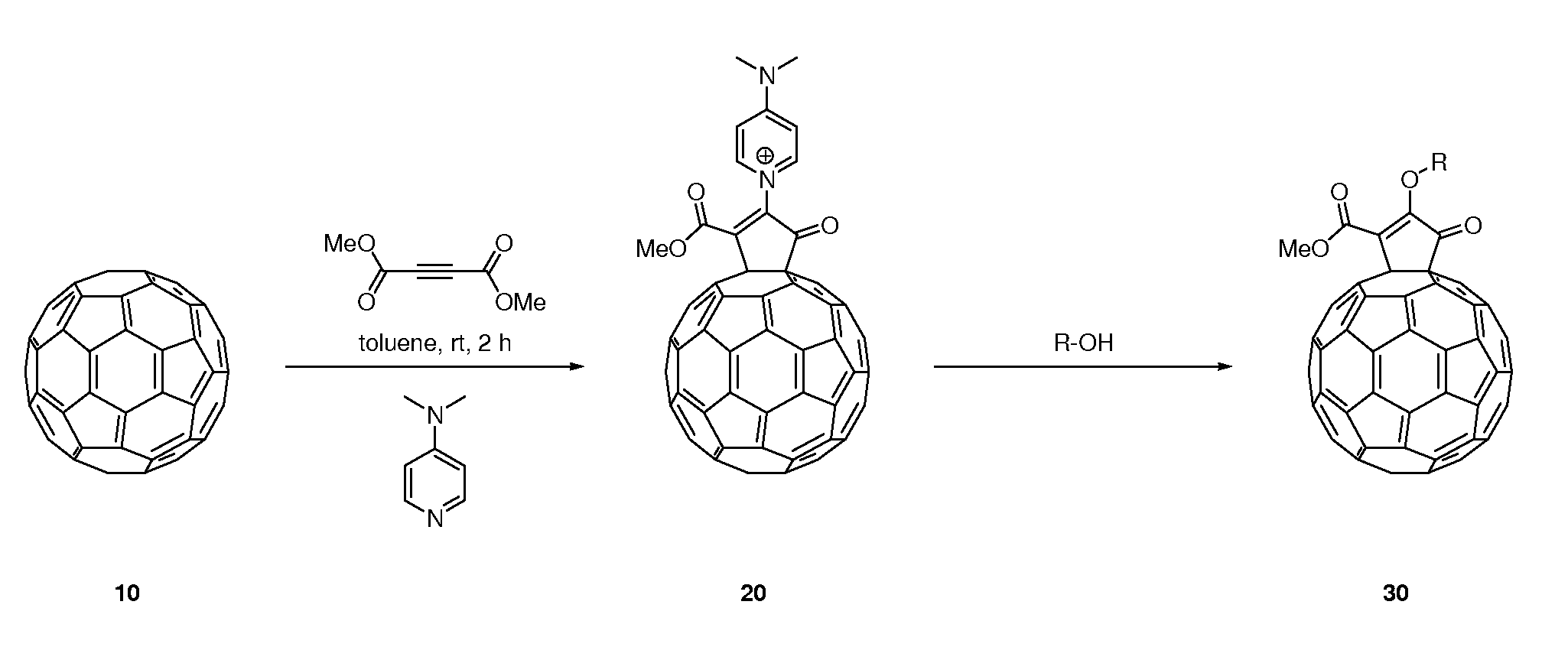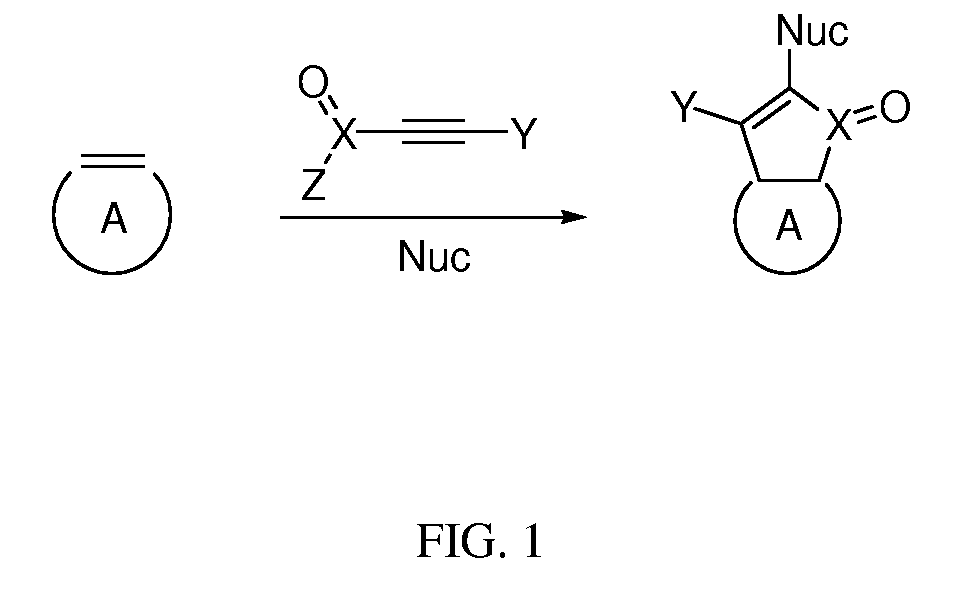Functionalization of nanoscale articles including nanotubes and fullerenes
a nanotube and fullerene technology, applied in the field of functionalization of nanoscale articles, can solve the problems of high temperature, long reaction time, and/or strong base or strong acid
- Summary
- Abstract
- Description
- Claims
- Application Information
AI Technical Summary
Benefits of technology
Problems solved by technology
Method used
Image
Examples
example 1
[0066]Functionalized fullerenes were synthesized according to the following general procedure, with N,N-dimethylaminopyridine (DMAP) as the nucleophile and dimethyl acetylenedicarboxylate (DMAD) as the alkyne, to obtain a vinyl methoxy fullerene analog. A mixture of C60 (10 mg, 0.014 mmol) and DMAP (4.4 mg, 0.036 mmol) in toluene in a 25-mL Schlenk tube was sonicated using an ultrasonic bath (Branson 2510, W, 42 kHz) until a homogeneous violet solution was obtained. To the resulting mixture was injected a solution of DMAD (3.4 μL, 0.028 mmol) in toluene (0.5 mL) dropwise. After addition of DMAD was complete, the system was stirred at room temperature for 0.5 h followed by the addition of methanol (0.5 mL). The resulting mixture was further stirred for another 2 h. The solution was concentrated and the residue was subjected to column chromatography. The product was obtained as a red solid (8.1 mg, 68%). Some fullerene starting material was also recovered (1.9 mg, 19%).
example 2
[0067]A vinyl 2-methoxyethyloxy fullerene analog was synthesized using the following procedure, with N,N-dimethylaminopyridine (DMAP) as the first nucleophile, dimethyl acetylenedicarboxylate (DMAD) as the alkyne, and 2-methoxyethanol as the second nucleophile, to obtain the product. A mixture of C60 (10 mg, 0.014 mmol) and DMAP (4.4 mg, 0.036 mmol) in toluene in a 25-mL Schlenk tube was sonicated using an ultrasonic bath until a homogeneous violet solution was obtained. To the resulting mixture was injected a solution of DMAD (3.4 μL, 0.028 mmol) in toluene (0.5 mL) dropwise. After addition, the system was stirred at room temperature for 0.5 h followed by the addition of 2-methoxyethanol (0.5 mL). The resulting mixture was further stirred for another 2 h. The solution was concentrated and the residue was subjected to column chromatography. The product was obtained as a red solid (7.7 mg, 62%). Some fullerene starting material was also recovered (2.1 mg, 21%).
example 3
[0068]A single-walled carbon nanotube (SWCNT) analog was synthesized using the following procedure, with DMAP as the nucleophile, DMAD as the alkyne, and 2-methoxyethanol as the second nucleophile, to obtain the product. A suspension of purified SWCNTs (4.0 mg, 0.33 mmol of carbon) in THF (40 mL) was sonicated for 3 min using an ultrasonic probe (Branson Sonifier 450, 60 W, 20 kHz). The heterogeneous solution was heated at 60° C. To the SWCNT suspension were added simultaneously a solution of DMAD (0.51 mL, 4.2 mmol) in THF (10 mL) and a solution of DMAP (0.51 g, 4.2 mmol) in THF (10 mL) via syringe pump within 40 h. (In cases where a second nucleophile is required to obtain the product, the second nucleophile may be added after the addition of DMAD and DMAP completed, and the mixture may be stirred at 60° C. for another 12 h.) The reaction mixture was centrifuged at 5000 rpm for 5 min. The supernatant was discarded and the residue was dispersed in DMF for 5 min using an ultrasonic ...
PUM
| Property | Measurement | Unit |
|---|---|---|
| pKa | aaaaa | aaaaa |
| pKa | aaaaa | aaaaa |
| temperature | aaaaa | aaaaa |
Abstract
Description
Claims
Application Information
 Login to View More
Login to View More - R&D
- Intellectual Property
- Life Sciences
- Materials
- Tech Scout
- Unparalleled Data Quality
- Higher Quality Content
- 60% Fewer Hallucinations
Browse by: Latest US Patents, China's latest patents, Technical Efficacy Thesaurus, Application Domain, Technology Topic, Popular Technical Reports.
© 2025 PatSnap. All rights reserved.Legal|Privacy policy|Modern Slavery Act Transparency Statement|Sitemap|About US| Contact US: help@patsnap.com



